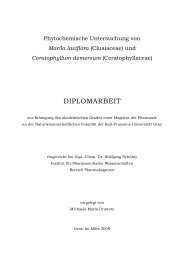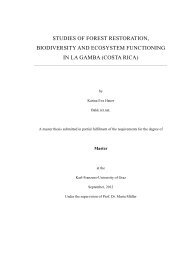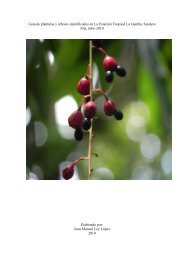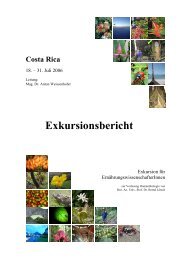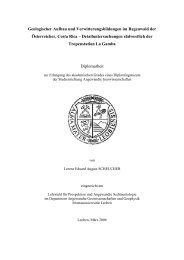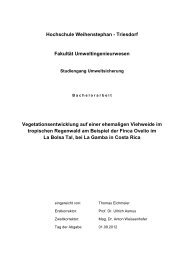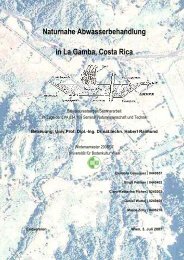Leaf colour patterns, vegetative and sexual reproduction of Episcia ...
Leaf colour patterns, vegetative and sexual reproduction of Episcia ...
Leaf colour patterns, vegetative and sexual reproduction of Episcia ...
You also want an ePaper? Increase the reach of your titles
YUMPU automatically turns print PDFs into web optimized ePapers that Google loves.
2. The subfamily <strong>of</strong> Epithematoideae (6 genera/75 species) is distributed in India, from<br />
Southeast Asia to Malaysia. In West Africa <strong>and</strong> from Central America to Peru only one<br />
representative can be found. The most varied genus is Monophyllea with roughly 30 species.<br />
3. The subfamily <strong>of</strong> Gesnerioideae (53 genera/ 1500 species) is spread in the Neotropics.<br />
Some genera are: Besleria, <strong>Episcia</strong>, Drymonia, Allopectus, Nautiocalyx, Paradrymonia, Gesneria,<br />
Sininngia <strong>and</strong> Columnea.<br />
4. The subfamily <strong>of</strong> Coronatheroideae (9 genera/ 20 species) has representatives on the<br />
Solomon Isl<strong>and</strong>s, the Antilles, in New Caledonia <strong>and</strong> the south <strong>of</strong> South America. The most<br />
varied genus is Coronanthera.<br />
In 1829 the genus <strong>Episcia</strong> was described for the first time by Karl Friedrich Philip Martius in<br />
his work “Nova genera et species plantarum”. The name stems from the Greek word "episkios"<br />
which means shaded. The plants can be found predominantly at shady <strong>and</strong> damp places, slopes,<br />
banks or rocks.<br />
The genus <strong>Episcia</strong> was modified drastically by Wiehler (1978) <strong>and</strong> reduced from 46 to nine<br />
species: E. <strong>and</strong>ina, E. cupreata, E. elongata, E. fimbriata, E. lilacina, E. prancei, E. reptans, E. sphalera, E.<br />
xantha. Before the new division <strong>of</strong> Wiehler the definition <strong>of</strong> the genus was only based on floral<br />
<strong>and</strong> fruit characters. The genus <strong>Episcia</strong> united several species, which today belong to the genera <strong>of</strong><br />
Nautilocalyx, Paradrymonia <strong>and</strong> Alsobia. <strong>Episcia</strong> <strong>and</strong> Alsobia differ from Nauticalyx <strong>and</strong> Paradrymonia<br />
in their stoloniferous habit <strong>and</strong> their sympodial shoot pattern. Whereas <strong>Episcia</strong> is a terrestrial or<br />
saxicolous genus <strong>and</strong> owns two stolons per node, Alsobia lives strictly as an epiphytic <strong>and</strong> has<br />
only one stolon per node (Wiehler 1983). Also the newest investigation <strong>of</strong> Clark (2006) confirms<br />
the monophyly <strong>of</strong> <strong>Episcia</strong> within the Episcieae.<br />
<strong>Episcia</strong> consists <strong>of</strong> stoloniferous low terrestrial or epiphytic herbs, which are rarely lignified at<br />
the base. The stems creep or sprawl on the ground but with erect or rising tips. The plants can<br />
reach one meter or more in length. At the nodes there can be adventive roots.<br />
The leaves are <strong>of</strong>ten crowded or opposite with short petioles. The leaf form varies from<br />
ovately or elliptically to lanceolately. Usually the leaf pairs are nearly equal. The upper surface is<br />
dark green or has various <strong>patterns</strong> <strong>of</strong> variegation. The lower surface is <strong>of</strong>ten <strong>colour</strong>ed.<br />
The inflorescences <strong>of</strong>ten consist <strong>of</strong> single or 2-6 axillary flowers on slender pilose peduncles.<br />
They are also furnished with two bracts. The showy flowers are zygomorphic. The floral tube is<br />
short. The calyx is <strong>of</strong>ten irregular <strong>and</strong> owns five oblong sepals, which are free or shortly connate<br />
at the base. The sepals are pilose <strong>and</strong> green or <strong>colour</strong>ed. The posterior lobe is forced back around<br />
a corolla spur. The corolla inserts horizontally in the calyx, has the form <strong>of</strong> a more or less<br />
developed tubus <strong>and</strong> is conspicuously spurred. Above the spur <strong>and</strong> at the throat the corolla can<br />
14



